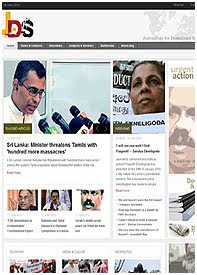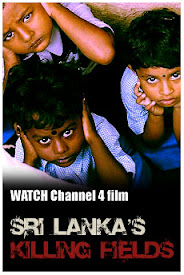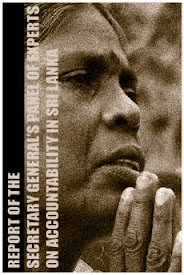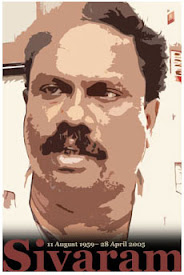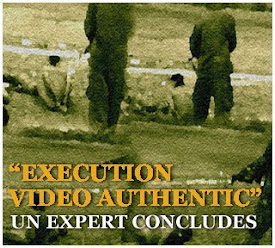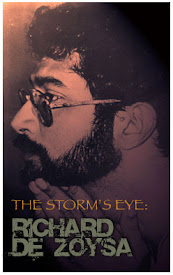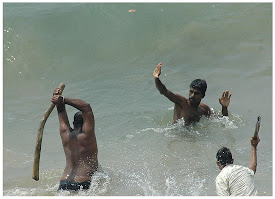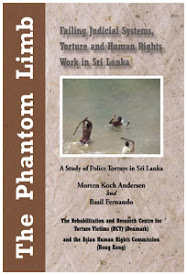

Police in Sri Lanka say that a team is assigned to investigate the attack on a BBC reporter in Polonnaruwa.
Thakshila Dilrukshi Jayasena was attacked allegedly by the supporters of the government after covering election related violence on Wednesday.
A clash has erupted between supporters of President Mahinda Rajapaksa and the Janantha Vimukthi Peramuna (JVP).
Senior government minister Maitreepala Sirisena and JVP’s former JVP provincial councillor Indrananda Silva were seen among the clashed supporters.
The female journalist was assaulted as she was leaving after covering the clash and her equipment and jewellery were robbed.
It is the first violent incident against journalists in Sri Lanka in the run up to the elections.
Police is currently recording a statement from Ms. Jayasena who was admitted to the hospital with injuries.
© BBC Sinhala
Wednesday, January 13, 2010
SRI LANKA: BBC REPORTER ASSAULTED
Wednesday, January 13, 2010
POLICE SEARCH SUNDAY LEADER OFFICE


The Sunday Leader office located in Ratmalana was search by armed police officers who had come in a bus a short while ago. The police officers searched the printing press of the office saying they had information that defamatory posters were being printed at the premises.
However staff members at the office said that the police, which included the OIC of the Mt. Lavinia police, did not search the editorial section of the newspaper. The police had a search warrant.
The police had also videoed the printing press of the newspaper. Sunday Leader Editor Federica Janz confirmed to Daily Mirror that the Sunday Leader office was searched.
Head of the police elections desk DIG Gamini Navaratna told Daily Mirror online the search operation was carried out following information obtained by the police.
© Daily Mirror
Wednesday, January 13, 2010
One freed, but what about the others silenced in Sri Lanka?

By Bob Dietz/Asia Program Coordinator - With Monday’s release of J. S. Tissainayagam on bail, maybe things are looking up for the media in Sri Lanka. CPJ welcomed Tissainayagam’s release from a sentence of 20 years' “rigorous imprisonment,” but called on President Mahinda Rajapaksa to extend him a full pardon, as it is within his presidential powers to do. For now, at least, Tissa, as he is known, is out of his prison cell though not free to leave the country—the appeal court that set him free demanded that he hand over his passport as part of the bail agreement.
But there are many other cases still hanging in the air in Sri Lanka that will not go away, even though they are making their way through the courts.
Last week, a friend in Sri Lanka forwarded me a story from the country’s Daily Mirror that reported from court documents about the murder weapon used in the January 2009 killing of The Sunday Leader’s editor-in-chief, Lasantha Wickramatunga. The investigation into Wickramatunga’s death is still moving ahead, glacially, in the Mount Lavinia Magistrate’s Court in Colombo. The coroner’s autopsy (in Sri Lanka it’s called the Judicial Medical Officer’s (JMO) Report) was never released, though the court had recorded the cause of death as gun shot injuries. The Daily Mirror reported:
“The JMO who conducted the post mortem inquiry had revealed Lasantha's death had been caused not due to gunshot injuries, but injuries caused to his head with a sharp weapon. The cause of death as gunshot injuries had apparently been recorded based on entries made by the medical officer who recorded his admission to the hospital.”
It may seem gruesome, but there is great significance in the specifics of how the well-known editor was killed. When CPJ first reported Wickramatunga’s death on January 8, 2009, we quoted The Sunday Leader’s staffers as saying he was killed with guns equipped with silencers. They said that witnesses at the scene—he was killed at around 10 a.m. on a busy road while on his way to work by eight men on four motorcycles—heard no gunshots fired, which they would have surely heard even over the busy traffic noises at the intersection where he had been forced to pull over.
“His assailants bashed in the window of the car before shooting him in the chest and head, according to colleagues and local and international news reports,” we said in our initial alert on the day he was killed.
CPJ repeated those assumptions in subsequent alerts and blogs, and it wasn’t until I got to Colombo in February that I began to be told a more horrible angle to the story. I was working on a CPJ special report, Failure to Investigate, an investigation not only into Wickramatunga’s killing, but the January 6 attack on Sirasa TV, and the January 23 attack on another newspaper editor, Upali Tennakoon and his wife, Dhammika.
Several sources, all of whom insisted on anonymity, told me that Wickramatunga was killed not by gunshots, but by piercing his skull with a “sharp pointed metal rod” and that the other weapons used were pointed wooden poles. Convinced by the sources’ access and integrity, we reported the murder weapon as a metal pole in Failure to Investigate.
The sourcing had been bolstered after I interviewed Tennakoon and his wife in the hospital room where he was recovering from his wounds—Dhammika had also been injured, but not as seriously. They said the four men on two motorcycles who attacked them used wooden and iron poles similar to those described by our sources, who were working from the evidence they had from Wickramatunga’s wounds, not from evidence at the scene of the crime. One of the attackers also stabbed at Upali with a knife, but it was deflected and only nicked his stomach.
The next hearing in Wickramatunga’s case will be on January 21.
This is a two-part blog entry. Tomorrow, I’ll talk about the relevance of these cases to the elections coming up on January 26, and why it is not likely that the anti-media atmosphere that was part of the government’s all-out effort to win the war with Tamil secessionists is not likely to end soon.
© CPJ Blog
Wednesday, January 13, 2010
TISSAINAYAGAM LEAVES PRISON

Photo Courtesy of Daily Mirror
Tamil journalist J.S. Tissanagayam, who was serving a 20-year prison term, left Welikada Prison today (Jan. 13) after signing his bail application in the court.
His release order had been communicated to prison authorities.
A two-member panel of appeal court judges considered his application for bail two days ago, and freed him on a Rs. 50,000 bail.
Tissanayagam was ordered to hand over his passport to the court.
He was arrested in March 2008 and after a prolonged detention was indicted under the Prevention of Terrorism Act and Emergency Regulations in August same year.
After a 20-day hearing, the Colombo high court found him guilty of trying to create communal disharmony and aiding terrorism through his 'North Eastern Monthly' magazine.
© Colombo Today
Wednesday, January 13, 2010
Lanka exonerates UN over Alston

By Amreen Ameen - The Sri Lankan government refused to blame the UN for the report made public by the Independent Special Rapporteur Philip Alston on the Channel 4 video, which allegedly showed troops killing unarmed LTTE cadres at point blank range.
When Daily Mirror online contacted the Secretary to the Ministry of Disaster Management and Human Rights, Professor Rajiva Wijeysinha, he responded to a question about Ban ki Moon distancing himself from Alston by saying that what Alston says is sometimes wrongly presented by the media as being said by the UN.
“The actual position is that Philip Alston is an Independent expert appointed by the UN, but cannot make decisions. He simply raises issues for UN bodies to consider,” Professor Wijeysinha said.
Professor Wijeysinha noted that the UN high commissioner for Human Rights Navanethan Pillay, who had also made statements on Sri Lanka’s human rights situation on earlier occasions, would not have gone public with a statement like Alston did on the basis of a video.
Meanwhile Government Defence spokesman Minister Keheliya Rambukwella, speaking to Daily Mirror online, said that Philip Alston had violated the laws and ethics and as a result Sri Lanka is not prepared to look at the report as it is not considered credible.
“We also do not know who the experts are and their designation,” he said with reference to the three experts quoted by Alston in his analysis report which claimed that the Channel 4 video was authentic.
He further said “four months ago we had appointed experts with academic qualifications who proved with scientific evidence and credibility that the video was fabricated.”
UN Secretary General Ban ki-moon, on Monday, distanced himself from the controversy arising over the Channel 4 video on Sri Lanka by telling reporters in New York that the UN special envoy on extra judicial Killings Philip Alston is acting independently.
© Daily Mirror
Wednesday, January 13, 2010
Sri Lanka poll violence escalates after killing

Sri Lankan police Wednesday broke up clashes between political activists as violence linked to looming presidential polls escalated after gunmen shot dead an opposition party worker.
Tear-gas was fired to disperse thousands of party workers in the eastern town of Polonnaruwa, local officials said by telephone.
About 3,000 opposition supporters destroyed a ruling party office in the town after posters of their favoured presidential candidate, Sarath Fonseka, were destroyed overnight, a police official said.
"It was a mini-war between rival groups," said the official, who declined to be named. At least five people were seriously wounded in the clashes.
The violence came as the government vowed to step up security in the run up to the January 26 election at which President Mahinda Rajapakse is seeking re-election.
Opposition leader Ranil Wickremesinghe accused Rajapakse's People's Alliance of inciting violence and using intimidation to swing voters.
"People linked to the government were behind yesterday's killing," Wickremesinghe told reporters in Colombo.
Opposition activist Kusuma Kuruppuarachchi, 60, was gunned down Tuesday as she was travelling in a bus to attend Fonseka's election rally in the southern town of Hungama.
Local politician Mangala Samaraweera said the victim had been warned several times by ruling party activists against campaigning for Fonseka in an area which is considered Rajapakse's home constituency.
A statement from Rajapakse's office condemned the shooting, in which several other people were wounded, and pledged the attackers would be brought to justice.
"The government of Sri Lanka is appalled at this tragedy, vehemently condemns it, and will not tolerate any such acts of violence in the midst of this democratic electoral process," the statement said.
The US embassy in Colombo said it was "deeply concerned" over the killing and escalating violence.
Fonseka quit the army and entered politics in November over differences with Rajapakse, who accused him of trying to seize power after crushing the separatist Tamil Tiger rebels.
Sri Lankan elections have been marred in the past by violence but Tuesday's shooting was the first fatality in the current campaign.
© AFP
Wednesday, January 13, 2010
Looking for a new media culture and media freedom

Photo Courtesy of http://indi.ca/
S. Viswanathan - For journalists in South Asian countries, particularly the conflict-ridden, terror-prone areas of Afghanistan, India, Pakistan, and Sri Lanka, 2009 was one more year of murderous attacks by state and non-state players. Twelve journalists lost their lives during the period, with Pakistan accounting for seven of them.
In addition to this information, the annual report, “South Asia Media Monitor, 2009,” of the South Asia Media Commission (SAMC) reveals that during the year hyper-commercialisation, monopolisation, and excessive political clout chipped away at professional and ethical norms, most disturbingly in India and Pakistan.
“The situation for the functioning of a free media rapidly deteriorated as vested interests outmanoeuvred editorial controls,” the report commented without any exaggeration, adding: “Confronting the fallout of the global economic downturn, media outlets that have had a buoyant growth in recent years laid off hundreds of their staff deflating professional morale in the region where physical threats abound.”
The 180-page report highlights events involving high-risk duties, casualties, threats, and intimidation in the eight South Asian countries — Afghanistan, Bangladesh, Bhutan, India, Maldives, Nepal, Sri Lanka, and Pakistan. On top of Pakistan’s seven, the deaths reported were two in Afghanistan, and one each in India, Sri Lanka, and Nepal. The report finds fault with state authorities for failing to bring to justice the killers of the journalists.
“India is far from a safe haven for journalists”
Aside from calling attention to the increase in the incidents of violence against mediapersons, the SAMC report gets into the ongoing debate in India on the ethics of news coverage (“paid news” and “selling news space”) in the print and broadcast media. The deplorable phenomenon of “paid news” and “selling news space” has emerged as a great threat not only to media freedom but also to fair, free, and democratic elections. The report comments on the paradox that the world’s largest democracy enjoys a freer and more sophisticated press than do many of its neighbours — and “yet India is far from a safe haven for journalists.” The violence unleashed on TV channels, the assaults on several respected journalists, and the brutal murder of Anil Majumdar, Editor, Aji , who was campaigning for peace talks between the government and the United Liberation Front of Asom (ULFA), raise disturbing questions about the state of freedom of the media and the safety of journalists, especially critical and crusading journalists.
Even though the number of journalists killed in the region (12) in 2009 was significantly lower than in the previous year (22), the incidents of violence against them registered a steep rise, worsening the situation on the ground in Pakistan, Sri Lanka, and Afghanistan. In Pakistan, the SAMC report observes, “some zealots in the profession have used their new freedoms to scandalise and destabilise a fragile democracy, ignoring media norms quite frequently.” Further, some leaders of the ruling party used threatening language against some mediapersons. The year 2009 began with the detention of a journalist (on January 3). The very next day, a cameraman of a television channel and a freelance journalist fell victim to a gas cylinder blast in a suicide attack. Three weeks later Amir Wakeel, editor of a newspaper, was shot dead in Rawalpindi. Four more journalists lost their lives in the following months. The SAMC report observes that the ongoing conflict in the frontier regions of Pakistan and Afghanistan and the surge of terrorism brought tremendous pressure on journalists, making the task of reporting the truth “a hazardous affair.”
“Sri Lankan journalists suffered the most”
Although Pakistan accounted for seven of the 12 journalists killed last year in five of the eight south Asian countries under study, it was journalists working at great risk under extremely hostile conditions in battle-torn Sri Lanka who suffered the worst adversities in the region by all standards, according to the report. In the commission’s view their sufferings were “more serious than even the travails that their counterparts in Pakistan have faced.” The brutal murder of Lasantha Wickrematunga, one of the island nation’s widely known editors, the “abduction-style arrest” of N. Vithyatharan, and the 20-year jail term imposed on J.S. Tissainayagam, a pro-LTTE journalist, on charges of “terrorism” represent a new low. The report asserts: “Many top journalists had to flee the country fearing for their life.”
Wickrematunga, Editor, Sunday Leader, who was known for his strong views against the government, was shot dead on January 8, 2009. “The fearless editor was known for his courage and forthrightness in speaking truth to power,” the SAMC report says. Besides exposing “the corruption, nepotism, racism and bad governance of the government,” the newspaper was also “critical of the government’s warmongering”; it advocated “a negotiated settlement to the ethnic crisis.” Natesapillai Vithyatharan, editor of “ Sudar Oli,” was arrested and interrogated for long hours for alleged links with the Liberation Tigers of Tamil Eelam. Many other employees of the newspaper and its allied publications received death threats. Even more shocking was a court order that convicted Tissainayagam (on August 31) on charges of “supporting terrorism and inciting racial hatred in his articles” and sentencing him to a 20-year jail term. He was the first Sri Lankan journalist to be convicted under the anti-terrorism law. The verdict sent shock waves across the region and journalists and human rights organisations were highly critical of the sentence. “The verdict is a big blow to freedom of the press in the whole South Asian region,” said SAMC Chairperson N. Ram and Secretary General Najam Sethi in a statement.
A review of the report says: “Press freedom in Sri Lanka is direly imperilled, following the hard won victories against the Tamil rebels, the Sri Lankan Government seems to have adopted a zero tolerance policy for dissent.” In the assessment of Reporters Sans Frontiers (RSF), Sri Lanka is the least respectful of media freedom among all democratic countries in the world. “Assaults on journalists are widespread, and there appears to be very little political will to protect them,” says the review, which cites an attack on the studio of a television and broadcasting organisation on the grounds that it gave inadequate coverage to the government’s victories on the battlefront. RSF also refers to the denial of the right of journalists to cover several important events, the bar on some foreign journalists entering the country, and the expulsion of some. What was most striking was the solidarity of Sinhalese journalists with all those who came under attack or extra-constitutional pressure.
South Asia Media Monitor, 2009, which stresses the need for a shared discourse in the South Asian region on media freedom and also on the need to help evolve a healthy and progressive media culture in the light of the shared experiences, is eminently worth reading.
© The Hindu
This site is best viewed with firefox

Search
Is this evidence of 'war crimes' in Sri Lanka?
Archive
- ▼ 2010 (1312)
- ► 2011 (687)
Links
- Reporters Sans Frontières
- Media Legal Defence Initiative
- International Press Institute
- International News Safety Institute
- International Media Support
- International Freedom of Expression eXchange
- International Federation of Journalists
- Committee to Protect Journalists
- Asian Human Rights Commission
- Amnesty International
